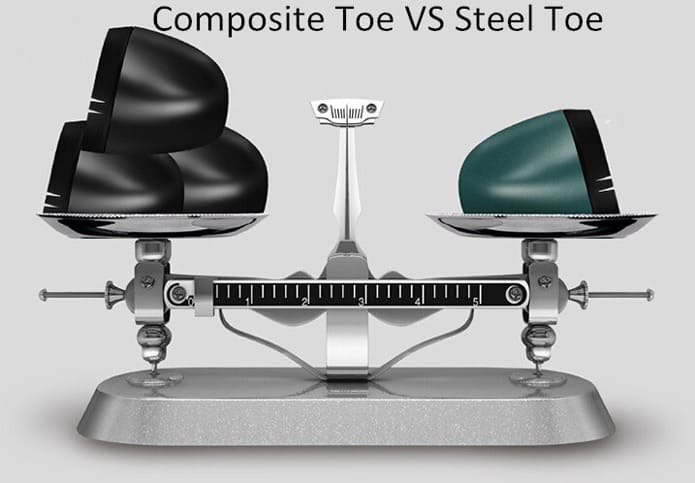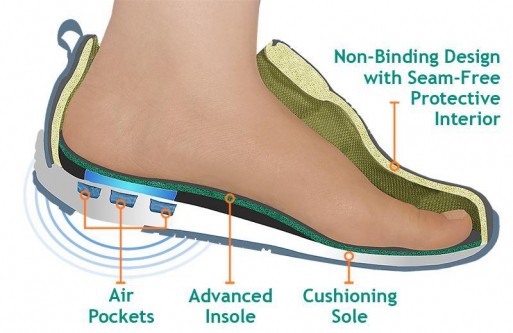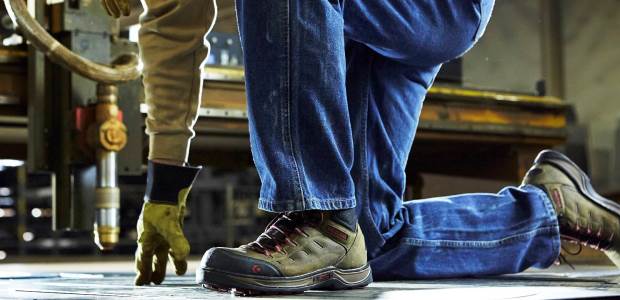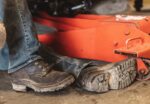Are you a construction worker?
OR
Work in a nuclear industry or in an airport?
So, you are sure to end up in the confusion of selecting between boots steel toes and composite toes.
Right?
In this article I am going to solve all your queries regarding which is better…
Steel toe cap or a composite toe cap?

I am going to compare both of them under various factors and tell you which outstands the other in which factor and why…
So, that you can decide the best for your feet.
Composite vs Steel Toe Work Boots Comparison Table
Composite toe |
Steel toe |
|
| Material | Carbon, plastic, fiberglass | Steel |
| Weight | Lighter | Heavier |
| Cold weather | Does not conduct cold | Conducts cold |
| Set off metal detector | Do not set off | Yes only in some cases |
| Comfort | More comfortable | Less comfortable |
| Protection | Good | More protective |
| Durability | Decreases after one accident | More durable |
| Price | More expensive | Less expensive |
Difference Between Steel toe and Composite toe
Steel toe boots are trusted for ages by workers of different sectors. They came in market long before the composite toe caps and ruled the markets for centuries because there were no issues or complaints against them leaving only the weight factor.
That is when the composite toe caps were introduced to provide comfort. Composite toe caps are light weight and comfortable.
But, are they as safe as the steel toe caps?
Well, there are various factors which should be taken into consideration to decide the best among the two.
Let’s have a detailed study regarding them:

1.) Are Composite toe as Safe as Steel toe shoes?
Answer me one thing using simple logic…
One of your feet is covered with steel plate and the other with plastic or carbon fiber. Now, a heavy load falls on your feet.
Which feet will be safe?
The one covered with steel plate or the one covered with carbon fiber?
Obviously, the one covered with steel will be safe because steel can withstand more compression pressure than plastic or carbon.
But, in the recent times, composite toe caps are such designed that they can withstand more or less similar pressure and provide the same amount of safety. Still, I think they can’t beat the steel toe work boots.
2.) Are Composite toe Boots OSHA Approved?
Want to know what OSHA is?
Well…
I will explain all about it…
The full form of OSHA is Occupational Safety and Health Standards. The Personal Protective Equipment (PPE) section which covers footwear safety and health standards is included in the section of OSHA.
OSHA recommends conducting an assessment either by company’s safety personnel or by a consultant to determine the need for PPE and the types of footwear that the employees should wear.
OSHA requires employees to wear only those foot wears which comply with their standards and issues fine if the standards are not met.
Now, the question is, are boots composite toe OSHA approved?
The answer is while most composite toes are ANSI and OSHA approved, the cheaper ones are not.
3.) Do Composite toe Boots Get Cold?
This can very well be explained through common sense. Metal is a good conductor of heat and cold and therefore gets cold.

But composite toe is made of non-metal materials like Kevlar, plastic, fiber glass and carbon fiber. Therefore, being non-metal composite toe do not conduct cold and thus don’t transfer cold from the environment to the feet.
4.) Is Composite Safety Toe Stronger than Steel?
Composite materials are generally made by mixing of more than one non-metal. Therefore, they are such molded that the final product becomes stronger than their individual counterparts.
Steel being one single metal, is strong but can’t beat the composite ones which are thus made keeping in mind their strength.
5.) Steel vs Composite Toe Weight:

The simple answer is being made of steel, obviously steel toe shoes are heavier than the composite toes. But composite toes have to be thicker in terms of offering the same protection as a thin steel toe can. Generally, composite toes are 30% lighter than the steel toes.
6.) Composite toe v/s Steel toe Comfort:
Comfort definitely becomes a major concern when it comes to buying your boots. The first thing that comes to our mind while talking about comfort is the weight of the boots. Obviously steel toes are heavier than the composite toes being made of metal.
But how much can a toe cap’s weight contribute to the discomfort? Well, when you are on your feet for the entire day, even a small discomfort may turn into a big problem and cause fatigue.

But comfort always does not mean the weight. Many other factors too come under consideration like cushioned insoles, padding, breathability, insulation, material and support.
So, while thinking about comfort, not only steel toes and composite toes make the difference, but the other factors too become even more important.
7.) Composite toe v/s Steel toe Protection:
People usually think that composite toes are better when it comes to electrical hazard protection then the steel toes. But, this is wrong. Steel toes equally and easily pass the electrical hazard protection safety standard set by ASTM.
There is another factor under protection and that is the hardness of the material. Obviously, being made of steel, the steel toes offer better protection in case of any falling and rolling objects because composite materials are not as hard as the steel ones.
But, here again another things comes into question that the steel might even itself be dangerous for your toes as in the process of getting hit by the falling object, it might itself break and cut your toes and there is no chance of this situation with a composite toe.
8.) Composite toe v/s Steel toe Impact and Compression
Footwear manufacturers rate and test their shoes and boots according to the standards set by the ASTM international. The relevant standards for a footwear with a protective toe cap are ASTM F2412 and ASTM F2413.

The ASTM F2413 standard specifies that toe cap must be first tested for impact and compression. The test and methods for impact and compression are specified by ASTM F2412 standard as follows:
1. Impact test:
It is concerned with the effect of what happens when something very heavy falls on the shoes or boots.
2. Compression test:
It is concerned with the effect of what happens when something very heavy rolls on the shoes or boots.
So, in ASTM tested footwear, the toe cap will offer the same level of protection irrespective of the material it is made of-whether steel or composite.
But though composite toes pass the initial impact and compression test, but the composite material apparently tend to weaken after the first tests.
They might crack when a heavy load falls on them. Therefore, it is always advisable to replace to the composite toe after the occurrence of one accident.
See also: ASTM vs ASME Standards: Whats the Difference?
9.) Composite toe v/s Steel toe Metal Detector
 Since composite toe is not made of metal, therefore the composite toe boots do not set off metal detectors like the steel ones. Therefore, composite toe boots are safer for workers in the nuclear stations, security checks, and airports.
Since composite toe is not made of metal, therefore the composite toe boots do not set off metal detectors like the steel ones. Therefore, composite toe boots are safer for workers in the nuclear stations, security checks, and airports.
But, in the modern times, steel toe boots are too such designed as to pass the metal detectors. But there is always a risk associated with the steel toes passing the metal detector test.
10.) Composite toe v/s Steel toe Material
Composite toe is made of non-metal materials like Kevlar, plastic, fiber glass and carbon fiber. On the other hand, as the name suggest, steel toe caps are completely made of thin sheets of steel.
Therefore, composite toe caps are lighter than the steel toe ones and are more comfortable.
11.) Composite toe v/s Steel toe Cold Weather
If you live in cold countries, you need to keep your feet warm and vice versa.
Steel being a good conductor of heat and cold conducts the cold from the environment inside your boots to the feet.
While on the other hand, composite toe caps being made of non-metals do not conduct cold from the atmosphere and keep your boots warm if you wear thick socks.
Therefore, composite toe caps should be your choice if you live in cold weather countries.
12.) Composite toe v/s Steel toe Durability

When it comes to durability, both composite toe and steel toe are durable. But being made of steel, steel toe caps are more durable in case of successive compressions due to heavy load.
The reason is composite toe is made of non-metal and cannot withstand compression as their steel counterparts.
When a heavy load falls on the composite toe, they save your toe from the load, but in the process, itself breaks off or cracks. Therefore, it needs to be changed after encountering a load which is not the case with the steel toe caps.
13.) Composite toe v/s Steel toe Pros and Cons:
Steel toe:
Composite toe:
Which one to wear when?
When to wear steel toe boots?
You should wear steel toe boots if you are a construction worker or brick layer or in any profession which poses the hazard of heavy impact falling on your toes while working.
When to wear composite toe boots?
Composite toe caps are made from non-metals which means that they will not set off metal detectors and therefore great for those working as an electrician or engineer or airports, etc.
Composite toe vs Steel toe Test
There are basically two types of tests that safety toe boots have to undergo according to the ASTM testing standards: impact test and compression test, where impact test is the test wherein a heavy object is dropped on the safety toe caps and compression test is the one wherein a heavy object is rolled over the safety toe footwear caps.
Both the steel toe caps and composite toe caps are tested for both impact and compression test and both show very similar result of impact resistance. But one difference that comes out is that a composite toe cap can withstand only a single impact after which it tends to crack.
The declaration of test results show that composite toe caps can withstand impact up to 1.5 metric tons or 200J and that a steel toe cap can withstand impact up to 6000lbs or 2500 pounds or 1133 kg.
Before we say Good Bye:
As you see…
Both composite toe caps and steel toe caps have their own pros and cons.
I think by now you know which is better for you.
It all depends on the weather you are living in and the protections your work environment demands.
If you live in cold countries, steel toe work boots is for you.
If you’re a nuclear plant worker or an airport employee, composite safety toe is for you.
If you are a construction site worker, steel toe is for you.
Do let us know in the comment section below what do you is the right choice for you and why.
Till then take care.
And as we say…
Keep walking!







